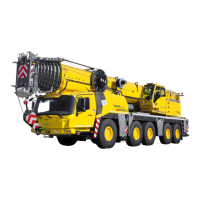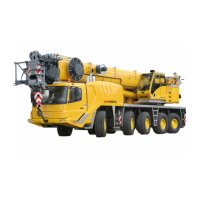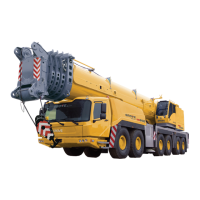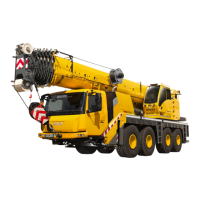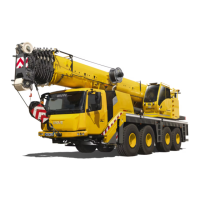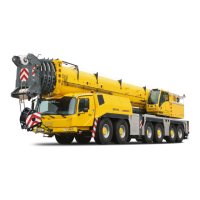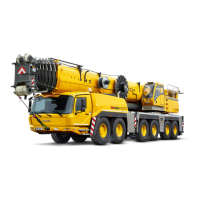Maintenance overview
5.4 Measures required for winch monitoring
09.03.2018
Maintenance manual 3 302 744 en 5 - 23
GMK5250L
Determining
the operating
conditions
(load spectrum)
The truck crane's load spectrum is divided into groups (see also ISO 4301/1,
FEM 1.001):
H
When determining the load spectrum, the existing rope pull is used as the
standard, i.e. under certain circumstances, the truck crane can be support-
ing a small load, whereby the winch is actually supporting a heavy load, e.g.
due to insufficient reeving. Therefore, the following graphic representation
of the load spectrum refers to the winch's rope pulls.
s
Load
spec-
trum
class
Definition Timing period proportions Factor of
the load
spectrum
Km =
Graphic representation
Light
Q 1
L 1
Power units or parts
thereof that are subject
to high stress in excep-
tional situations, but
which are generally sub-
ject to only low stress
10% of the timing period with
greatest load (dead load +
1/1 payload)
40% of the timing period with
dead load + 1/3 payload
50% of the timing period with
dead load only
0.125
Medium
Q 2
L 2
Power units or parts
thereof that are subject
to high stress quite fre-
quently, but which are
generally subject to only
low stress
1/6 of the timing period with
greatest load (dead load +
1/1 payload)
1/6 of the timing period with
dead load + 2/3 payload
1/6 of the timing period with
dead load + 1/3 payload
50% of the timing period with
dead load only
0.25
Heavy
Q 3
L 3
Power units or parts
thereof that are subject
to high stress frequently
and medium stress con-
tinuously
50% of the timing period with
greatest load (dead load +
1/1 payload)
50% of the timing period with
dead load only
0.5
Very
heavy
Q 4
L 4
Power units or parts
thereof that are regularly
subjected to the highest
stress from adjacent
stress sources
90% of the timing period with
greatest load (dead load +
1/1 payload)
10% of the timing period with
dead load only
1

